Figures Traced in Light: On Cinematic
Staging
[1] Introduction
[2] Revising Our Sense
of Feuillade
[3] Mizoguchi the Inexhaustible
[4] Cheerful Staging: Hou’s
Early Films
[5] Staging and Stylistics:
Some Further Business
[6] Misprints, Mistakes, and Missed
Opportunities
Mizoguchi the Inexhaustible
Preparing this sidebar for Figures Traced in Light, I
can’t help but recall a fall day in 1969. It was then that I
came out of the old Bleecker Street Theatre in Greenwich Village,
tears pricking my eyes. Sansho the Bailiff struck me
with an impact it retains on every viewing; sometimes I feel that
I shouldn’t watch it again, for fear that its lustre will
dim. It’s a wonderful film to see in your early twenties,
based as it is upon the painful ties to your home and the sense
that going into the world can soil you forever. (Why is it named
after him? I always ask my classes. Isn’t it a bit like
changing the title of Othello to Iago? My own
view is that for Mizoguchi the world we live in, unhappily for
us, belongs to its bailiffs.) A couple of years later I would see Chikamatsu Monogatari, Ugetsu, Life of Oharu, and Street of Shame. By the late 1970s, I
was convinced that Mizoguchi was one of the masters of world
cinema.
Indeed, you could make a credible case that the two greatest
directors in the history of film were both Japanese. Ozu Yasujiro
and Mizoguchi Kenji are opposed in many respects; for one thing,
Ozu has a rich sense of humor and Mizoguchi displays virtually
none. But both understood that cinema is at once a narrative,
performative, and pictorial medium, and they explored all three
dimensions. Their explorations were highly original, while
remaining deeply indebted to tradition. In Ozu and the
Poetics of Cinema (Princeton University Press, 1988), I
tried to show that Ozu’s work is a thoughtful effort to build
a stylistic system that had the rigor of the mainstream
continuity style but that permitted a range of more nuanced and
playful effects. Chapter 3 of Figures Traced in Light paints Mizoguchi as a more eclectic artist. I emphasize his
visual side while also trying to show how his pictorial
intelligence affected his storytelling and his conception of
performance. In the following reflections I trace out some issues
I didn’t pursue in the book. I’ve had to restrain myself,
for I’d love to examine in detail virtually all his films.
For the student of cinematic artistry, his work is
inexhaustible.
A Master of Editing?
Critics have rightly celebrated Mizoguchi as the supreme exponent
of the long take, but his early work displays a command of most
of those resources of editing that emerged in world cinema during
the 1920s. As my chapter indicates, his earliest surviving film, Song of Home (1925) displays thorough knowledge of the
continuity system promulgated by American cinema. Like his
contemporaries, Mizoguchi made effortless use of the 180-degree
system, eyeline matching, matches on movement, cuts linking
adjacent spaces, point-of-view shots, and all the other editing
devices we associate with mainstream commercial cinema of the
period. No long takes of the sort we’ll find in his
1930s silent films are evident in Song of Home.
Instead, Mizoguchi here enlists in the tradition of what I’ve
called “piecemeal decoupage,” the analytical approach
characteristic of the contemporary-life films
(gendai-geki) made at the Shochiku studios. Like Ozu,
Naruse, and other exponents of this style, Mizoguchi varies his
shot scales a bit more than an American would. For example, when
the scholar offers Naotaro a reward for saving his daughter, no
setups are repeated across the five shots.
- (plan-americain) The scholar offers Naotaro some
bills.
- (close-up) Bills in the scholar’s hand.
- (ms) Naotaro and friend, three-quarter view.
- (ms) Naotaro’s point of view: the scholar extends the
money to the camera.
- (mcu) Reverse angle: Narotaro looks at the money extending
into the shot.
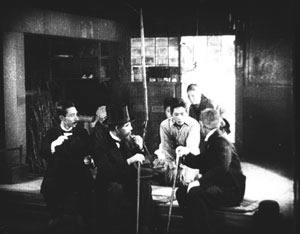
Fig. 3A.1
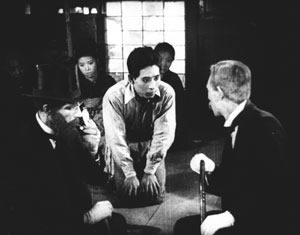
Fig. 3A.2
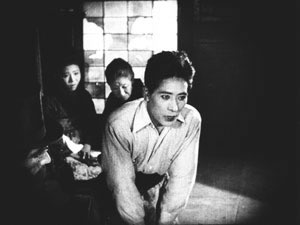
Fig. 3A.3Still, if we’re looking for a prefiguration of
Mizoguchi’s later work, this film exhibits cutting patterns
that show a sensitivity to foreground/ background
relations.
In the climactic scene, when the professors come to Naotaro’s
house to offer to fund his education, Mizoguchi covers the entire
scene in thirty-eight shots (plus eight intertitles), and
although some setups are repeated, there is a delicate variation
in the framings, each of which brings different dramatic elements
to our notice. We start with the overall ensemble (Fig. 3A.1),
eventually move to Naotaro flanked by the two educators (Fig. 3A.2), before reaching the climax, showing Naotaro and his mother
and sister behind him, as he declines to leave the countryside.
“Getting an education is good, but I must be a farmer who is
independent and self-aware” (Fig. 3A.3).
Other editing trends were at play in world cinema of the 1920s,
and Mizoguchi seems no less aware of them. French, German, and
Russian directors, as well as some U.S. filmmakers, experimented
with rapid cutting, made rhythmic by increasingly brief shot
lengths. This tactic was also pursued in Japan, particularly by
directors working in the swordplay genre (chanbara).
It’s likely that some of Mizoguchi’s lost films would
bear traces of this influence, but even in the condensed version
of Tokyo March (1929) we can glimpse this tendency in a
fast-cut tennis match. A similar moment of visual rhetoric
appears in The Poppy (1935), when Ono, walking the
street with his sweetheart, encounters the wealthy young woman
who’s out to seduce him. Their encounter is played out in a
flurry of very short shots:
- Ono and Sayoko talking; she runs into close-up.
- Low angle: After Sayoko nearly bumps into a rickshaw, Ono
steps up.
- (ms) Ono looks right. (25 frames)
- Reverse-shot: Fujio in the rickshaw, stares. (15
frames)
- (ms) Ono, as 3, still looking. (13 frames)
- Fujio, as 4. (39 frames)
- (ms) Ono and Sayoko, looking. (35 frames)
- Slight jump cut: Ono looking, as 5. (13 frames)
- Fujio, as 6. (11 frames)
- All three; after a pause, Fujio orders the driver to
continue. Ono and Sayoko stare after her.
The accelerating/ decelerating editing, reminiscent of Feuillade
in our the webpage extract from L’Orpheline, is a
good example of the sort of visual flourish that was common in
silent cinema. It was infrequent in the mature sound cinema,
though we can find it in Hitchcock’s work and in
Hollywood’s “montage sequences” of the 1930s and
1940s. This rhythmic editing scheme recurs in several films of
the 1960s, e.g., A Hard Day’s Night (1964) and the
climax of The Good, The Bad, and The Ugly (1966).
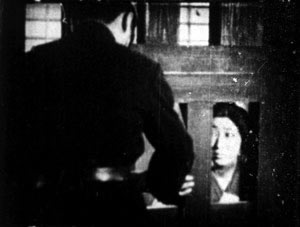
Fig. 3A.4
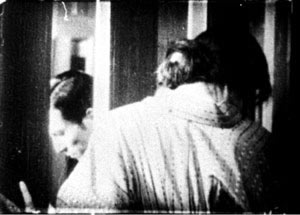
Fig. 3A.5
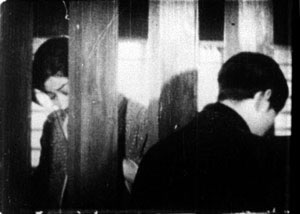
Fig. 3A.6Such editing flourishes are also on display in Taki no
shiraito (White Threads of the Waterfall, 1933), in
a swift montage that inserts pulsating flashbacks to a coach ride
into a scene showing Taki making up for a performance with. No
less impressive is the climactic courtroom scene. Taki faces the
judges, one of whom is the young man she has supported through
law school. My chapter points out that there are some forty-five
camera setups for the scene’s eighty-five images, and I
indicate the remarkable way that Mizoguchi creates dramatic
impact through insisting on rapidly cut singles of Taki and her
judges, with tight depth-composed close views (Figs. 3.19 and 3.20,
p. 100). The whole effect is reminiscent of Dreyer’s La Passion de Jeanne d’Arc (1928). And despite the
film’s frequent long takes, Mizoguchi can always spare a
moment for a very creative cut, as when after Taki has begged Kin
to save her, they pass to the bars of her cell. Amid several
aperture framings (for example, Fig. 3A.4 (right); compare Figs.
3.116 and 3.117 in the book, from Sansho the Bailiff), Mizoguchi
gives us a startling graphic match showing the two of them in
similar positions, the slats maintaining the aperture conceit
(Figs. 3A.5 and 3A.6).
On the evidence we have, it doesn’t seem that Mizoguchi
simply went from being a cutting-based director to being a
staging-based one. The fancy cutting just mentioned occurs in
films that also rely on long takes and ensemble staging. It seems
that for a time he held both approaches in balance (as Welles did
in Citizen Kane, The Magnificent Ambersons, Othello, and Touch of Evil). In the surviving
films from 1936 to 1941 Mizoguchi favored staging-based effects,
but after the war he resumed the pluralistic approach seen in the
earliest surviving films. Audacious though his editing
occasionally was, he didn’t construct an alternative,
full-bodied system as Ozu did over the same period.
The Love of Sumako the Actress (1947)
This remarkable film, as I note in the chapter, recalls the
daring experiments in depth and darkness Mizoguchi undertook in Naniwa Elegy and Story of the Last
Chrysanthemum. It might be regarded as his last effort in
this direction before moving toward the flexible, pluralistic
style of his last decade.
Mizoguchi’s audience would have recognized Matsui Sumako as a
scandal-plagued celebrity. Between 1912 and 1919 she and her
mentor-lover Shimamura Hogetsu helped create modern westernized
drama in Japan (shingeki), and her tours and recorded
songs made her a household name and the prototype of the free
woman. Shimamura’s associates often portrayed Matsui as an
unsophisticated prima donna who lured the weak-willed director
away from his wife and children. (See Phyllis Birnbaum, Modern Girls, Shining Stars, the Skies of Tokyo: 5 Japanese
Women [New York: Columbia University Press, 1999], pp. 1 to 52.) But Mizoguchi wanted Yoda’s script to present her as
“feminine and sympathetic,” displaying “the
psychology of a modern woman” (quoted in Yoda Yoshikata, Souvenirs de Kenji Mizoguchi, trans. Koichi Yamada,
Bernard Béraud, and André Moulin [Paris: Cahiers du
cinéma, 1997], pp. 70, 74). In this he was following not
only Occupation censorship guidelines but also an alternative
view of his heroine. For many, Matsui showed that a woman could
find success in a rigid society on her own terms. Her demands,
even her tantrums, showed her supreme dedication to her art and
to Shimamura’s goal of modern theatre. This dedication,
admirers pointed out, explains why she committed suicide soon
after his death and following her triumphant portrayal of
Carmen.
At first, however, the film gives us very little access to
Sumako. One might expect that a biography of the actress would
begin with her early life, or at least the circumstances that
lead up to her joining drama school. Instead, as so often in
Mizoguchi’s films, the man’s life is presented first, and
the woman enters it. The opening scenes show Shimamura teaching,
conferring with his colleagues, and casting Sumako as Nora in A Doll’s House. The plot traces his growing
affection for her, emphasizing the damage it does to his family
and the contrition he feels. In the sequence when he leaves his
household forever, he apologizes to his wife, his mother, and his
daughter—who has lost a suitor because of her father’s
affair with Sumako. In this version of history Shimamura emerges
as no weakling, but rather a man so committed to the ideals of
modern drama, including the liberation from convention, that he
must live them outside the theatre.
The plot has a fascinatingly “staggered,” or
shifting-spotlight structure. Shimamura has the initiative in the
first eighteen sequences, and he is present in every scene except
one, when Sumako is pushed to leave her home after Shimamura
abandons his family. The result of concentrating on Shimamura is
to deny us access to Sumako’s mental life when she isn’t
around around others; we are given only one glimpse of her
dutifully studing her part. Once Shimamura starts living with
her, the narrational focus fastens on the couple, usually seen
among their theatre troupe as they struggle to find and sustain
success. Nine sequences trace their life together, and in these
scenes Sumako is shown as short-tempered but also supremely
committed—urging the actors forward, demanding a decent
rehearsal hall, accepting endless tours to pay the bills. Once
Shimamura collapses, the narrative’s focus shifts decisively
to Sumako as she confronts Shimamura’s wife and mother and
decides to struggle on.
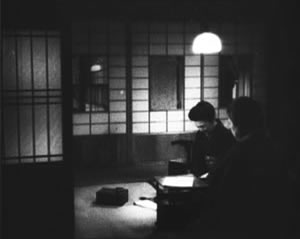
Fig. 3A.7 |
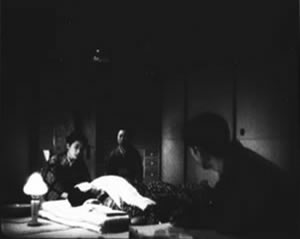
Fig. 3A.8 |
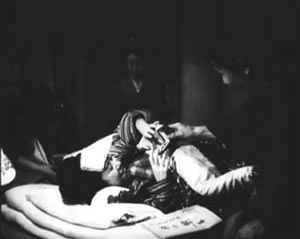
Fig. 3A.9 |
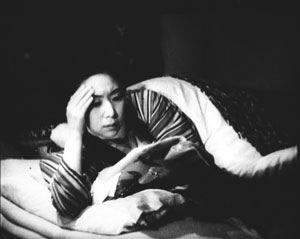
Fig. 3A.10 |
Kinugasa Teinosuke filmed a Sumako biography at the same time
(Actress, 1947) and filled it with close-ups, but most
scenes in The Love of the Actress Sumako consist of
distant framings, often in chiaroscuro. In one daring shot, as
Shimamura walks out on his wife and mother, his departure is
barely visible in a slot just above the heads of the two weeping
women (Fig. 3A.7). In keeping with the plot’s roundabout
treatment of its heroine, Mizoguchi reserves the closest shots of
Sumako for performances or rehearsals, as if to sharpen the
difference between theatre and life. A major turning point in
this stylistic pattern occurs when, as Sumako is ill, Shimamura
gives her a ring pledging their love. The camera tracks in with
him to a medium-shot of her lying down, the closest the camera
has come to her so far; she admires the ring, then carefully
turns back to studying her text (Figs. 3A.8 to 3A.10). Even in this
intimate moment, the narration is fairly circumspect about her
affection for her lover, instead stressing her dedication to her
art. Once Shimamura has died, however, we get the first and only
scene of Sumako alone. It is handled in a manner which we
instantly recognize, but it is followed by a shot-change which,
in the context of this film, is little less than shocking.
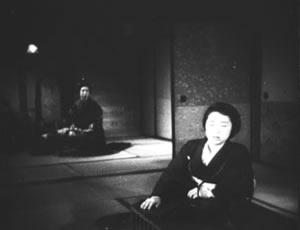
Fig. 3A.11 |
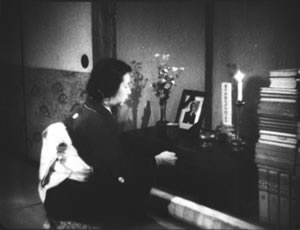
Fig. 3A.12 |
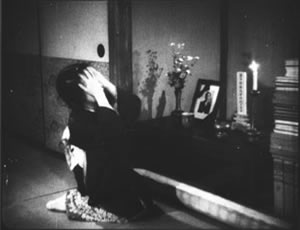
Fig. 3A.13 |
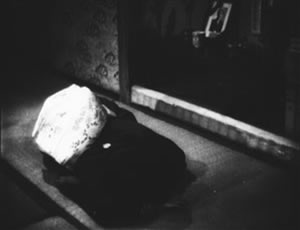
Fig. 3A.14 |
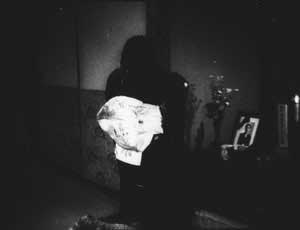
Fig. 3A.15 |
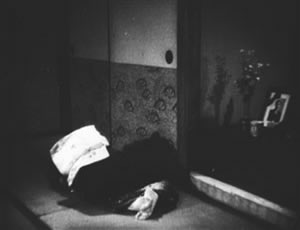
Fig. 3A.16 |
Sumako comes home from a performance and refuses to eat, sitting
disconsolately in the distant foreground (Fig. 3A.11). As so
often, Mizoguchi’s simple panning movement turns a long-shot
framing into a closer one, as she comes forward and rightward to
kneel before the memorial shrine she has created for Shimamura
(Fig. 3A.12). After lighting an incense stick, she asks how her
performance was tonight. After long pauses, she responds to his
silence by breaking down—first with her face more or less turned
toward us, then covered by her hands (Fig. 3A.13); then she curls
up in grief (Fig. 3A.14). She rises to beseech him one last time
before turning definitively from the camera and pressing into the
wall as the image fades out (Figs. 3A.15 to 3A.16). It is a typical
Mizoguchi emotional transition, from a full-face but distant view
to a closer but oblique one, until finally, as the
character’s despair reaches its height, dorsality and a
retreat from the camera take over.
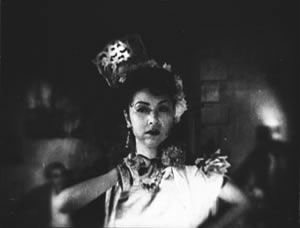
Fig. 3A.17 |
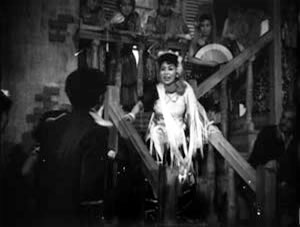
Fig. 3A.18 |
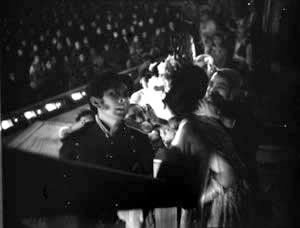
Fig. 3A.19 |
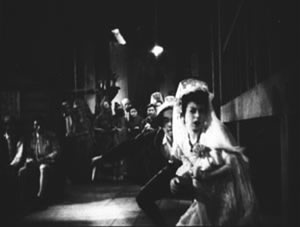
Fig. 3A.20 |
As I indicate in the chapter, this moment stands in for
Sumako’s suicide, which takes place between sequences at the
end of the film. This is the most private and intense display of
Sumako’s emotions to be found in the film. True to form,
however, Mizoguchi contrasts his reticent staging with the
following shot, which presents Sumako as a turbulent, demanding
Carmen (Fig. 3A.17), challenging us full-face as Ayako did at the
close of Naniwa Elegy (Fig. 3.47 in the book). Then,
after showing us the performance in a mix of tightly composed
shots and flamboyant depth (Figs. 3A.18 to 3A.19), Mizoguchi
provides a fascinating long-take scene of Sumako’s backstage
outburst, using one of his distant-depth compositions (Fig. 3A.20). There remain only her death as Carmen onstage (another
substitute for her suicide); the discovery of her hanged body;
and her funeral. As so often in Mizoguchi, the woman enters an
already-established world of men and money, and she leaves them
behind puzzling over what she has done.
© David Bordwell 2003. [1] Introduction
[2] Revising Our Sense
of Feuillade
[3] Mizoguchi the Inexhaustible
[4] Cheerful Staging: Hou’s
Early Films
[5] Staging and Stylistics:
Some Further Business
[6] Misprints, Mistakes, and Missed
Opportunities
|
|



